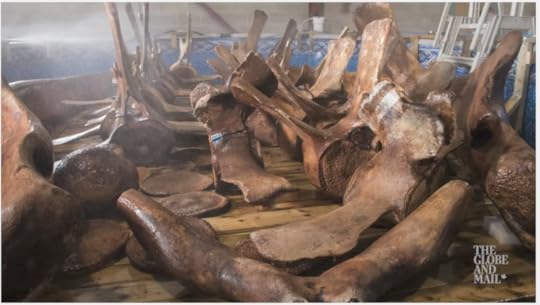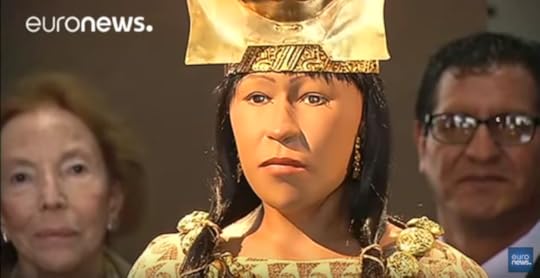Ripley Entertainment Inc.'s Blog, page 401
July 12, 2017
CARTOON 07-12-2017
July 11, 2017
CARTOON 07-11-2017
July 10, 2017
These Strange Treats Will Make You Hate Ice Cream
Featured in Ripley's Believe It or Not!

As summer heat hits its peak, we thought we’d share the strangest ice cream from around the world. Some might be just the treat you’re looking for, but others will make you wish you’d stuck with regular old vanilla.
The GOOD: Color Changing Ice Cream
Physicist Manuel Linares won’t reveal the secret to a chemical he developed that changes ice cream color as it melts. The unique ice cream turns from purple to pink as it warms up. The color changes using the same process flowers use to change color in nature and will warn you of impending sticky hands.

Bompas and Parr, a food design studio based in London, made a batch of glow in the dark ice cream. The cone was made to celebrate the release of The World’s End, the third film in a series of movies known as “the Cornetto trilogy”. By adding a UV-responsive vitamin, the cones glowed under black lights. They weren’t just cool, but also made eating easier at the dark theater. The cones and moviegoers mouths were both shining bright as the movie started.

The BAD: Breastmilk Ice Cream
The Icecreamists shop in London has one renowned flavor: Baby Gaga. The cream is made using human breast milk. The milk was donated from women who saw an online advertisement and was allegedly screened and pasteurized for safety. The treat is flavored with vanilla and lemon zest and sold for around $22.50. That may seem steep, but it sold out within days of being introduced.
“If it’s good enough for our kids, it’s good enough to use in our ice cream.” -Matt O’Connor, store founder
The UGLY: Beaver Urine
Believe it or not, a substance harvested from beaver urine sometimes makes its way into ice cream. Castoreum is excreted from beavers and used to mark their territory. The thick yellow fluid is sometimes used as a vanilla substitute, or as a part of strawberry flavoring.
While you might think a sundae is universally enjoyed around the world, you might not enjoy one in South Korea. There, a sundae is made by stuffing cow or pig intestines full of noodles and blood.

Bon Appetit!
CARTOON 07-10-2017
July 9, 2017
CARTOON 07-09-2017
July 8, 2017
CARTOON 07-08-2017
July 7, 2017
The World’s Biggest Heart Is Now on Display
Featured in Ripley's Believe It or Not!

Believe it or not, you can view the world’s largest heart at the Royal Ontario Museum in Toronto! The 440lb organ is on display next to its enormous skeleton for the exhibit Out of the Depths: The Blue Whale Story.
Discovery
The massive heart was found in 2014 when the blue whale carcass washed up on the shores of Trout River in Newfoundland. This is a surprising find because when a blue whale dies, their 300,000-pound frame sinks. Their corpses are so large and rich, that they typically act as their own underwater ecosystem for years after their death. Unfortunately, this whale was trapped in ice with eight other whales. Locals were worried it would explode because it was inflated with gas and the decomposition process wouldn’t be simple for something as massive as the blue whale. Thankfully the explosion was avoided since the whale has extremely thick skin.

The blue whale carcass via NTDTV

Screen shot from PatrynWorldLatestNew

Screenshot from The Globe and Mail
Plastination
Scientists were able to persevere the heart with the plastination technique since it was in exceptional conditions. The four-step process of fixation, dehydration, vacuum, and hardening keeps the organ from emitting any odors, prevents it from decaying and retains properties of the original specimen. Considering how much fat the heart had, it was a rather difficult process. It was given an acetone bath—yes, the same chemical you would find in your nail remover—that will now allow the heart to stay intact for 1,000 years!

Screenshot from The Globe and Mail

Screenshot from The Globe and Mail

Screen shot from PatrynWorldLatestNew
Royal Ontario Museum in Toronto
The exhibit Out of the Depths: The Blue Whale Story will tell you the incredible story of the evolution of these majestic sea creatures. It took three years to bring this exhibit to Toronto. Mark Engstrom, the Royal Ontario Museum’s deputy director of collections and research had wanted to bring this show for more than a decade. He’s collected the skeletons of many whales including the minke and humpback. Engstrom was missing the blue whale.

Screenshot from The Globe and Mail
Did you know?
This whale was a mature female.
Her heart measures 5 feet by 4 feet by 4 feet.
It pumps out 220 liters of blood per beat.
The blue whale can get to be 100 feet long.
Their tongues can weigh as much as an elephant.
Blue whales are among the planet’s longest-lived animals.
Blue whales feast on krill. They require almost 9,000 pounds of them, and around 40 million krill daily during the summer feeding season.
They can give birth to a baby whale weighing around 8,800 pounds with a length of some 26 feet.
Have you been to the exhibit? Let us know if the comments below and share your photos!
CARTOON 07-07-2017
July 6, 2017
CARTOON 07-06-2017
July 5, 2017
Lady of Cao’s Facial Reconstruction
Featured in Ripley's Believe It or Not!

More than 1700 years ago, the 20-something-year-old, Lady of Cao, ruled over a desert valley in ancient Peru. Her body was embellished with snakes, spiders, and religious symbol tattoos.
Huaca El Brujo (Sacred place of the Witch) is where the former priestess was discovered mummified in 2005. She was buried with her prized weapons and gold articles. The ancient archaeological site allowed for people to understand the Moche society.

The Lady of Cao screenshot from The Archaeology Channel

The Lady of Cao screenshot from The Archaeology Channel
Moche society
The Moche conquered the Chicama Valley from about 100 to 700 AD. Not only that but it was patriarchal. Huaca del Sol and the Huaca de la Luna are the two pyramids that were used for social and religious activities. Of course, the bodies were also left to rest in these holy pyramids.

Huaca del Sol CC Martin St-Amant via Wikimedia Commons
It’s been said that Lady of Cao’s tattoos represented an elite like quality since the tattoos are linked to the spiritual symbolism that is found throughout the Moche society. What makes this find so unique is that, what was once considered a male ruled society, has now been debunked. They found a total of eight queens, while priest-kings were also found. It seems that the society had a stable structure when it came to sexes.
One of the most famous tombs to have ever been located on the northern coastline of Peru was El Señor de Sipán (the Lord of Sipan). The discovery in 1987 led many to believe the society was male driven. Thirsty for blood, the Moche society celebrated nature by not only drinking blood but engaging in sexual acts and embracing death. The walls in their temple reveal such beliefs.

El Señor de Sipán tomb via Wikimedia Commons
The Moche society flourished way before the Inca empire ruled the Andes. They built canals to grow crops, created intricate goldwork and ceramics.
3D Imaging
Lady of Cao’s face has recently been revealed by Peru’s culture officials and archaeologists. Thanks to 3D imaging technology and forensics archaeology, they were able to create a lifesize model in ten months. The striking replica is based on her skull structure plus ethnographic research.

Lady of Cao Screenshot via euronews
Lady of Cao will be making her debut in Peru’s Culture Ministry in Lima till July 16. She will then be displayed at the museum, El Brujo.

Lady of Cao Screenshot via euronews
Did you know?
The Lady of Cao was buried with a crown, and gold and copper items.
The grave contained two war clubs and 23 spear throwers.
An autopsy revealed she had probably died of childbirth or pregnancy complications.
Near her grave was a strangled adolescent, who’s believed to have been a sacrifice to guide Lady of Cao into the afterlife.
Ripley Entertainment Inc.'s Blog
- Ripley Entertainment Inc.'s profile
- 52 followers










